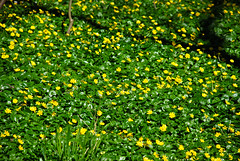Historically, a distinctive and beautiful display of white, purple, pink and yellow native spring wildflowers bloomed on the spacious floodplain along the banks of Rock Creek near Boundary Bridge (where Rock Creek enters D.C. from Maryland). But now they have largely been displaced by a carpet of lesser celandine.
 Non-native lesser celandine (Ranunculus ficaria) elbows out other spring-blooming flowers in fertile soil.
Non-native lesser celandine (Ranunculus ficaria) elbows out other spring-blooming flowers in fertile soil.
Photographer: Flickr user Adam FagenLesser celandine (also called fig buttercup) is an aggressively reproducing, robust non-native plant from Eurasia. It emerges green early in spring and flowers vibrant yellow along many of Rock Creek’s floodplains. After several weeks it goes dormant and remains underground until early the next spring.
Where does it invade from? Lesser celandine is a prolific producer of little bulblets that break free during floods. They join the seeds and other reproducing parts of other plants that wash into the creek from residential areas and woods upstream. As floodwaters recede, these all get deposited on the floodplains and take root, if conditions suit them.
Lesser celandine is also spreading to other rich, mesic areas upslope of Rock Creek's floodplains. National Park Service staff are managing this aggressive weed with herbicide treatments.


